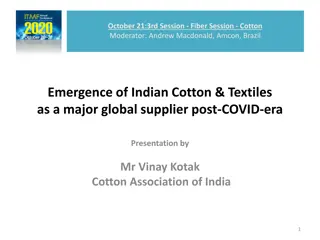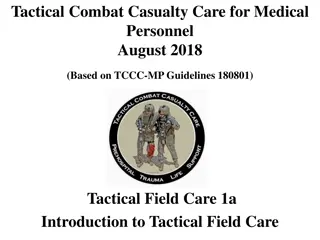Understanding Easy-Care and Durable Press Finishes for Textiles
Easy-care and durable press finishes play a vital role in enhancing the quality and longevity of textiles, particularly those made of cellulose fibers. These finishes reduce shrinkage, improve wrinkle recovery, and maintain fabric appearance. While beneficial, they may impact fiber flexibility and strength. Various chemical approaches are used for non-swelling finishes, ensuring fabrics maintain their smooth, just-ironed look through laundering.
Download Presentation

Please find below an Image/Link to download the presentation.
The content on the website is provided AS IS for your information and personal use only. It may not be sold, licensed, or shared on other websites without obtaining consent from the author. Download presentation by click this link. If you encounter any issues during the download, it is possible that the publisher has removed the file from their server.
E N D
Presentation Transcript
INTRODUCTION Easy-care and durable press finishes are generally applied to cellulose and cellulose blend fabrics, but other fibres can benefit from these finishes also. The sheen of calendered fabrics (permanent chintz) and the stand and hand of pile fabrics are generally improved by durable press finishes.
Cont. The primary effects of the easy-care and durable press finish on cellulosic fibres are reduction in swelling and shrinkage, improved wet and dry wrinkle recovery, smoothness of appearance after drying, and retention of intentional creases and pleats. The total crease recovery angle (CRA), that is the sum of the crease recovery angles of the warp and the fill directions of the fabric, increases from about 150 to about 300 . A fabric shrinkage of less than 5 % can usually be achieved.
Cont. An unavoidable side effect of the cellulosic crosslinking finishes is a reduction in the elasticity and flexibility of the cellulose fibres. This produces a considerable decrease in abrasion resistance and tear and tensile strengths on natural cellulose fibres. Easy-care and wrinkle resistance finish is mainly used for woven fabrics.
Mechanisms of easy-care and durable press finishing The primary cause of the shrinkage of cellulosic fibres is the fact that these fibres can readily absorb moisture. moisture facilitates internal polymer chain movements in the amorphous fibre areas by lubrication. It disrupts the internal hydrogen bonding between these polymer chains. This absorbed
Cont. Two different chemical approaches have been used commercially to produce non-swelling or durable press cellulose fabrics. The original approach is the incorporation of a polymerized finish in the pores of the fibres, so that water molecules cannot easily penetrate the fibre. The newer approach multifunctional crosslinking hydroxyl groups of adjacent cellulose molecules that hinder the swelling of the cellulose fibre. is the agents reaction with of the
Examples of textiles with easy- care and durable press finishes Easy-care and durable press finishes are applied to cellulose fabrics and fabric blends with high cellulose content that are laundered and which should maintain a smooth, just ironed appearance through the lifetime of the article.
Cont. Easy-care finishes are also useful in providing dimensional stability to knitted fabrics. This easy-care finish is also used for table and bed linen because the wrinkling of linen after washing is very marked. One special use of the cellulose crosslinking finishes are wash permanent chintz articles, produced by the heat and high pressure of calendering the impregnated fabrics.
Chemistry of easy-care and durable press finishes Easy-care finishing of cotton has been a major market success since the middle of the 1950s. During the 1960s and 1970s, concern about formaldehyde encouraged development of cellulose crosslinking finishes with low free formaldehyde levels. Continued research has provided products with formaldehyde content as well as products that are completely formaldehyde free. very low free
Formaldehyde-containing products TWO DIFFERENT CHEMICAL PROCESS ARE USED THE INCORPORATION OF A POLYMERIZED FINISH IN THE PORES OF FIBRE ,SO THAT WATER MOLECULES PENETRATE THE FIBRE. THE REACTION OF MULTI FUNCTIONAL CROSS LINKING AGENTS (RESINS) WITH HYDROXYL GROUP OF CELLULOSE MOLECULES THAT HINDER THE SWELLING OF CELLULOSE FIBRES. CAN NOT EASILY
Cont. RESINS ARE USED AS IT CREATE STRONGER (COVALENT) AND PERMANENT BOND WITH FABRIC THAT REDUCES CREASING TO A LARGER EXTENT. EXAMPLES ARE---- UREA FORMALDEHYDE RESINS MELAMINE FORMALDEHYDE RESINS.
The main properties of U/F products are DMU is highly reactive; finish baths have to be used in a few hours Low stability to hydrolysis, low durability to laundering High chlorine retention High content and release of formaldehyde Very high elastic resilience.
The main properties of M/F products are: Better stability to hydrolysis and better washing durability than U/F products Relatively high formaldehyde content and release Fewer problems with chlorine retention than U/F products More dimensional stability and stiffness (also for nylon and polyester).
Non-formaldehyde containing products N,N'-Dimethyl- 4,5-dihydroxyethylene urea (DMeDHEU) should not be confused with DMDHEU. DMeDHEU does not contain formaldehyde.
The main properties of DMeDHEU products are Formaldehyde free Very low reactivity Very low chlorine retention Limited durability to laundering Yellowing effect when not ether modified Price/effect ratio nearly 4:1 compared with DMDHEU Development of unpleasant odours, depending on the product formulation.
Application methods The most common application method for easy-care and durable press finishes is a pad dry cure procedure. In this process, the crosslinking reactant, catalyst, softener, and other components are dried on the fabric prior to the crosslinking reaction that takes place during the curing step.
Compatibility with other finishes In commercial use, easy-care and durable press finishes are frequently combinedwith other finishes to provide additional properties such as water and oil repellency, flame retardancy, soil release and the like. Often the combination of another finish with the cellulose crosslinking finish will result in a more durable effect from the first finish. Combination with pigment printing is very common because of similar chemistry to cellulose crosslinking agents and binders and the similar application conditions.
Evaluation methods for formaldehyde Two useful formaldehyde tests are- Qualitative test formaldehyde in fabrics Quantitative test for formaldehyde in air for the presence of
Qualitative test for the presence of formaldehyde in fabrics Add a small piece of fabric to 2 3 ml of a solution of 10 mg chromotropic acid per 100 ml of 72 % sulfuric acid. Warm the solution carefully to not more than 100 C for 1 min. A red to violet colour in the solution indicates the presence of formaldehyde.
Quantitative test for formaldehyde in air This is most conveniently done with testing tubes designed for this purpose (Dr ger tubes from Dr gerwerk AG, L beck, Germany, are an example). A colour change to a certain mark after a specified amount of air is drawn through the tube gives the formaldehyde concentration.

















































